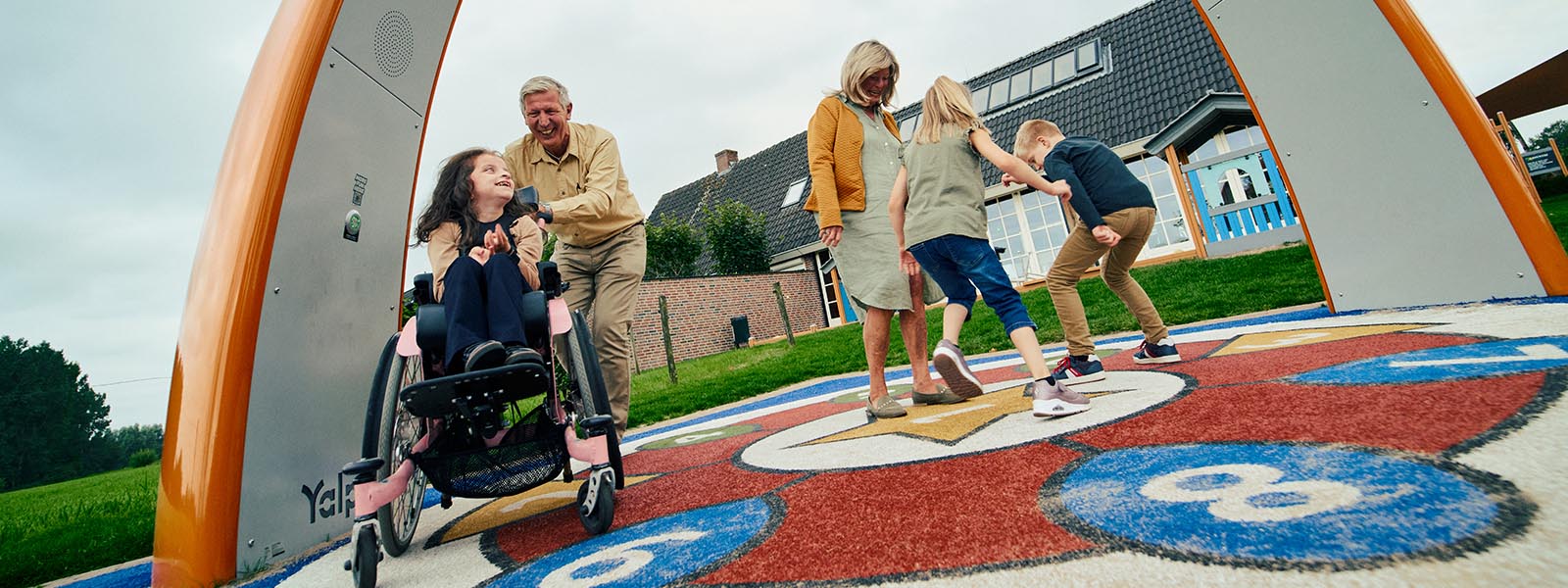Inclusive design makes a good starting point for planning
On an accessible playground, everyone can play, exercise and enjoy the outdoors equally. Accessible playgrounds call for careful planning, taking into consideration the diversity and diverse needs of the adults and children using the site.
Understanding user needs is key in planning an inclusive playground
People with functional and physical limitations refer to people whose ability to move, function, orientate themselves, or communicate is permanently or temporarily impaired due to a disability or illness. Functional limitations can vary from slight to severe.
Physically impaired persons include:
- weak-sighted and blind people
- the deaf, hard of hearing, and people with multiple sensory disabilities
- people with various physical limitations, whose functional capacity is impaired by, for example, musculoskeletal disorder, rheumatic disease, cerebral palsy, muscular disease, or dwarfism
- people with intellectual and developmental disabilities. Intellectual and developmental disabilities are often associated with multiple disabilities, physical disabilities, and impairments of vision and hearing, which create difficulties in orientation, understanding, and communication.
Approximately 16% of the global population suffer from different kinds of physical and functional impairments, making them a non-negligible minority: for approximately every fifth person, accessibility is an important matter.




Inclusive design helps create playgrounds that are suitable for everyone
Accessibility has been a talking point for a long time. Internationally, the expressions ‘design for all’ and ‘inclusive design’ are often used in conjunction with the topic. Both of these concepts refer to strategies and measures that are used to promote usability and accessibility to all users. One of the principles of these approaches is to include different users in all stages of the planning.
The aim is to offer all people equal opportunities to participate in society on all levels through inclusive design.
Taking inclusive design into consideration when choosing playground equipment is important. The entire playground and all its equipment should be accessible to all users. However, it is not enough to consider accessibility and inclusion in conjunction with single pieces of equipment; inclusive design has to be observed in the overall plan for the playground.

Inclusive playground in Lerum, Sweden
Elements of playgrounds and play equipment designed for everyone
When designing a playground for everyone, it is important to think about how people with various limitations can use the playground independently. The following best practices should be taken into consideration during planning.
1. Sufficient colour and tone contrasts
Play equipment should be available in various colours and tones. It is important that the contrast between the equipment and the background is good; for example, if a product is placed next to a green shrub, people with impaired vision should also be able to discern it from the shrub.
The ground (safety surface) under the equipment, as well as the passageways, should also contrast in tone with the rest of the area. A tonal contrast zone around the equipment also lets people with impaired vision know that the products are near.
The parts of each product should also be easy to differentiate – for instance, the tonal contrast between the support poles and the rest of the product should be prominent.
2. Good lighting
Playgrounds and equipment areas should be well-lit.
3. Passageways and their materials
The surface of the passageways on playgrounds should be hard, even, and nonslip, and it should stand out from the environment through its tonal and/or material contrasts. Passageways should be wide enough for unrestricted passage with a wheelchair and any other auxiliary equipment. To facilitate moving around, handrails by the passageways are a good idea. The passageways should also be well-lit.
4. Ramps
Any ramps on the passageways should be of sufficiently low gradient – preferably sloping no more than 6%. If there is a chance of slipping off the ramp, the ramp should be equipped with elevated edges.
5. Seats, tables, and platforms
A playground should offer seats of various heights, with backrests and armrests – something for people of all ages and heights.
6. Play equipment
Slides should be wide enough for a guardian or assistant to accompany an impaired person. Playhouses should be accessible by wheelchairs. The visibility of the first step of each product should be improved with contrasting colours and lighting.
7. Support poles
Many products are equipped with poles, which can be used as support (steps, climbing frames) or as handles to hold on to stay on the equipment (carousels). For a child to be able to get a sturdy grip on a pole, it should be narrow enough for a child’s hand.
8. Instructions
A playground should have instructions, which can be visual, aural, or tactile. The instructions should serve all people with impairments, and they should explain what the playground offers and where the passageways are. Tactile instructions, with embossed elements and Braille, should be available for people with impaired vision.

Multigenerational play under an orange Lappset Sona
Design for happiness
When talking about accessibility and inclusive design, we can talk about the design of happiness. What matters most is the right attitude – a human one.
Our future happiness and accessibility lie in the hands of today's designers, developers, and building contractors.
Construction professionals are in a key position in shaping people’s happiness and creating equality in everyday life – as well as on playgrounds. This project of creating happiness is one in which everyone should participate.
